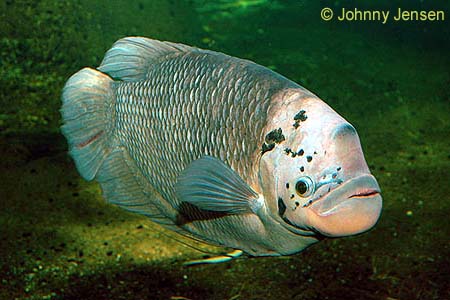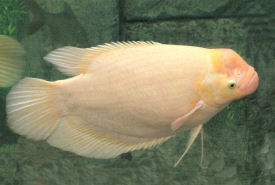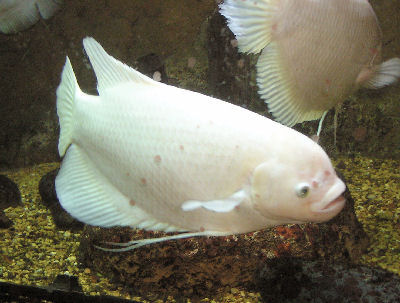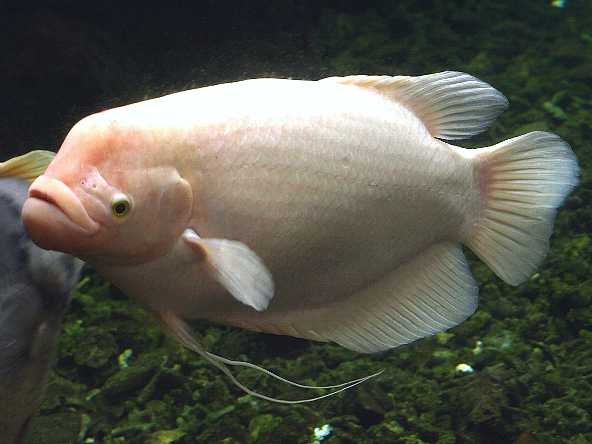
Osphronemus goramy
FAMILY
Osphronemidae
TAXONOMY
Osphronemus goramy Lacepйde, 1801, Mauritius; China; Jakarta
[Batavia], Java, Indonesia.
OTHER COMMON NAMES
French: Gourami gйant; German: Riesengurami; Spanish: Gurami
gigante, gurami comestible.
PHYSICAL CHARACTERISTICS
Largest species of anabantoids; up to 23.6 in (60 cm) and 19.8
lb (9 kg). High body, laterally compressed. Lateral line not interrupted
and nearly straight. Dorsal fin has 11–14 spines and
12–14 soft rays. Anal fin has 10–11 spines and 20–23 soft rays.
First soft ray of pelvic fin is very long, extending beyond caudal
fin. Labyrinth highly complex in the adult, with the numerous
folds supported by bony lamellae. Large males with
prominent hump on the head. Juveniles have eight to 10 dark
vertical bars and a conspicuous eyelike spot above the anal fin.
Adults drab, grayish, olivaceous above and silvery or yellowish
below in both sexes; no sexual dichromatism.
DISTRIBUTION
The species has been introduced in various areas outside of its
natural range. Its original
DISTRIBUTION
probably comprised
Thailand, the Malay Peninsula, Sumatra, Borneo, and Java. It
now has established populations in India, Sri Lanka, Philippines,
West Papua, Papua New Guinea, Madagascar, New
Caledonia, and Colombia.
HABITAT
Occurs in swamps, lakes, and medium-to-large rivers. May also
tolerate brackish water conditions.
BEHAVIOR
Nothing is known about the
BEHAVIOR
of the giant gourami in
the wild.
FEEDING ECOLOGY AND DIET
The giant gourami is omnivorous, feeding on plants, smaller
vertebrates, invertebrates, and even dead animals.
REPRODUCTIVE BIOLOGY
Reaches maturity after the fourth year. The male builds a spherical
to oval nest 11.8 in (30 cm) long, 7.9 in (20 cm) wide, and 3.9
in (10 cm) deep, which resembles a bird’s nest, close to or below
the water surface using mainly plant material. Nest building takes
eight to 10 days. Eggs are deposited in the nest, and guarded by
the male and female, and fanned through movements of the pectoral
fins. The yellowish eggs are around 0.11 in (2.7 mm) in diameter
and contain a large oil globule that makes them buoyant.
Eggs may number more than 1,500 per nest. Hatching occurs after
10 days. Newly hatched fry measure 0.24–0.35 in (6–9 mm).
Yolk sac is resorbed at around 15 days. After four months a
length of 3.9 in (10 cm) may be reached.
CONSERVATION STATUS
Not listed by the IUCN.
SIGNIFICANCE TO HUMANS
A valued, common, and delicious food fish, eaten steamed,
fried or baked. It has been introduced into more than 20 countries
all over the world, and is important in aquaculture in
tropical Asia.
Photo Gallery of - Giant gourami





 Animalia Life
Animalia Life